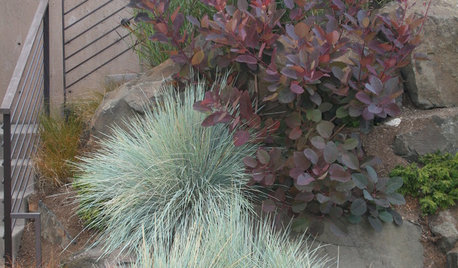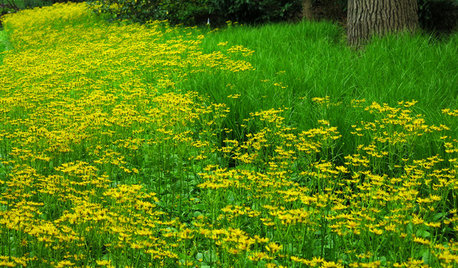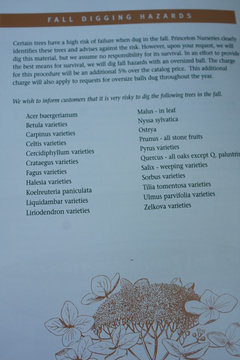Trees for Fall Planting vs. Trees for Spring Planting
edlincoln
8 years ago
Featured Answer
Sort by:Oldest
Comments (31)
ken_adrian Adrian MI cold Z5
8 years agoRelated Discussions
Fall vs. spring planting of apple trees
Comments (2)For apples in your zone, I think either fall or spring is ok, with some qualifications. If you're planting bare-root stock, fall planting would be OK as long as it weren't too late, early to mid October. Much later, and they might not have enough time to establish before freeze-up. Potted stock doesn't matter quite so much. As far as the shipping policies, it seems to vary quite a bit, but there are some nurseries which will ship in the fall. St. Lawrence Nursery in Potsdam, NY ships trees in the fall....See MoreShallots-Fall Planting vs Spring Planting
Comments (15)I planted shallots purchased at the feed store last fall.I got huge tops which bloomed but never died down.Finally ,I cut back all the tops in the spring, hoping the bulbs would finally get the message & mature to be harvested.Nope. Since then, I have a whole new crop of green shoots from multiple little unmatured bulbs. They just won't quit. People here use "onion tops" from shallots to sprinkle on gumbo & most everything else. Do I have a mutant Cajun shallot that never matures/develops a papery skin or am I missing something? I've grown onions before, so maybe I'm expecting onion type behavior from shallots.Don't stores sell mature shallot bulbs, though?? The original bulbs I purchased looked like that. I think......See MoreFall vs spring planting - fruit trees
Comments (2)I have around 100 different fruit trees all less than about 7 years old and most planted in the fall. It's definitely better to plant in the fall than in the spring. Peaches, apples, cherries, nectarines, pears, plums. All better in the fall. I tried pomegranates and a couple service trees, but they perished within a year of planting. Not sure the pomegranates were ready for the ground, but that's how they were advertised and I treated them the same as the others. Tried figs both mail order and from Lowe's and none of them worked out in the open. I'll keep trying them with cuttings I'm taking myself from neighbors. Benefit to planting in the fall is that the roots are growing even if the tops aren't doing anything. The tops will start putting out red/dark brown growth in late January into February and leaves later on when they're supposed to. I've only lost a few other trees, two cherries last summer because they flooded the weekend we had 10 inches of rain here. But that's rare and the rest of the trees in the immediate area were fine. One apple elsewhere because of all the rain and probably weak root system. But all else look good. I even had a couple crabapples and pears this summer that the deer got before I could. One of these days I'll be busy... :-) Stark Bros, One Green World (Pacific NW nursery), and Willis Orchard Co. (southern GA) are my favorites to mail order fruit trees from. All quality products for the most part, all packaged well. I like Miller nursery as well for their berry plants. And I just tried to go to their website and it says they're merging with Stark Bros, so that tells me they really did have a quality product. I hope that's what that means. :-)...See MoreFall vs spring planting?
Comments (1)I try to put about 1 1/2' between plants. I've had success with fall and spring planting, but they seem to do better for me with fall planting unless they are really tiny....See Moreken_adrian Adrian MI cold Z5
8 years agojoeinmo 6b-7a
8 years agoedlincoln
8 years agolast modified: 8 years agowisconsitom
8 years agoNHBabs z4b-5a NH
8 years agolast modified: 8 years agowaynedanielson
8 years agowisconsitom
8 years agoedlincoln
8 years agogardengal48 (PNW Z8/9)
8 years agoedlincoln
8 years agogardengal48 (PNW Z8/9)
8 years agowisconsitom
8 years agogardener365
8 years agoedlincoln
8 years agohairmetal4ever
8 years agogardener365
8 years agoedlincoln
8 years agoedlincoln
8 years agogardener365
8 years agoA J
8 years agowaynedanielson
8 years agosam_md
8 years agowisconsitom
8 years agoedlincoln
8 years agolast modified: 8 years agowaynedanielson
8 years agoedlincoln
8 years agowisconsitom
8 years agowaynedanielson
8 years ago
Related Stories

TREES7 Deer-Resistant Flowering Trees to Plant this Fall
If you live in a neighborhood with roaming deer, consider these beautiful trees that won't tempt hungry guests
Full Story
GARDENING GUIDESPlant Black Cherry Trees for the Birds and Bees
Plant Prunus serotina in the Central and Eastern U.S. for spring flowers, interesting bark and beautiful fall color
Full Story
GARDENING GUIDESPrunus Virginiana Thrives Under Deciduous Trees
Plant chokecherry for showy white flowers favored by native bees in spring, and to provide nesting habitat and food for birds
Full Story
PURPLE FOLIAGEGreat Design Plant: Smoke Tree
Plant a 'Grace' smoke tree for months of red, burgundy and purple foliage and an unusual spring bloom
Full Story
FALL GARDENINGWhy Fall Is the Best Time for Planting
Spring is overrated for planting. Starting plants in autumn has advantages for both garden and gardener
Full Story
FALL GARDENING5 Native Early-Spring Bloomers to Plant This Fall
Think beyond tulips and daffodils this year with plants that you and native pollinators will love
Full Story
TREESGreat Design Plant: Cascalote Tree for Sunny Southwestern Style
Enjoy lovely yellow flower spikes in fall and winter with this drought-resistant tree
Full Story
SPRING GARDENINGInspiring Raised Beds for Fall and Spring Planting
Make Your Next Vegetable Garden Even Better with Beautiful Boxes and Paths
Full Story
FALL GARDENING6 Trees You'll Fall For
Don’t put down that spade! Autumn is the perfect time for planting these trees
Full Story
GARDENING GUIDESGreat Design Plant: Amelanchier Signals Spring With Airy White Blooms
With roughly 20 species of serviceberry native to the U.S., bees can feed on the early-season blooms while birds enjoy the summer berries
Full Story





Toronado3800 Zone 6 St Louis